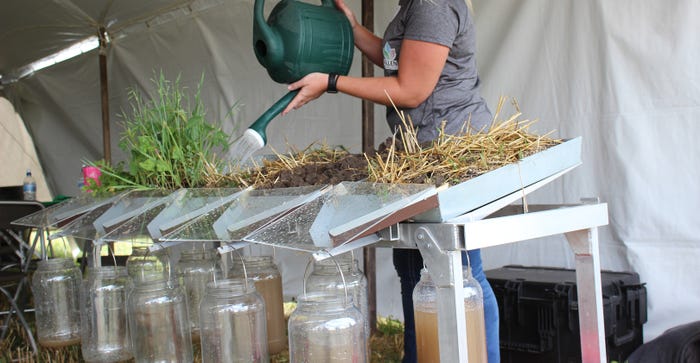
As concerns about water quality continue to make news, manure is sometimes viewed as a pollutant rather than a valuable source of soil nutrients. But when it’s properly managed, manure is better for both the soil and the environment than synthetic fertilizer, says Tom Menke of Menke Consulting. He spoke about the value of manure at the Ohio State University Manure Science Review held recently on the farm of Mark Watkins near Forest, Ohio.
The nutrients in manure are not as soluble as those in synthetic fertilizer, which is a benefit for water quality, Menke explained. At the same time, nutrient availability research has shown that the interaction between spring-applied manure and soil microbes benefits crops. “As the soil warmed up, the microbes released the phosphorus when the crop needed it,” he noted.
Manure also offers a broad source of all of the major, secondary and trace elements in various complex forms. It is good for the soil and for the things that make it alive and healthy, Menke stressed. For instance, manure improves soil biological properties, increasing aggregate stability and decreasing bulk density, which improves porosity of the soil and water-holding capacity. Manure also enhances soil’s biological properties, increasing populations of beneficial bacteria, nematodes and fungi as well as earthworms.
As farmers follow the 4R’s of nutrient management (right source, right rate, right time and right place), they should also consider a fifth R, the right data, Menke said. And based on available data, manure is the right form to use for applying nutrients. In addition to the benefits to soil quality and reduced nutrient solubility, manure is more cost-effective. Typically, the cost is 30% to 50% of the cost for the equivalent value of commercial nutrients, according to Menke. And, he added, manure often improves yields compared to synthetic fertilizer nutrients.
Addressing the problem with P
Menke went on to explain that higher-phosphorus soil tests don’t necessarily cause more water quality problems than low-soil-test fields. For example, he used the Ohio Phosphorus Risk Index to estimate P losses for no-till land in Darke County that has Blount silt loam soil and a 3% slope in a corn-soybean rotation. If the soil test P is 10 ppm and the farmer follows the Tri-State fertility recommendations and applies 165 pounds of P per acre, the combination of surface particulate P loss and surface-dissolved P loss is estimated at 1.064 pounds per acre. However, if the field has soil test P of 50 ppm, no additional P would be recommended based on the Tri-State guidelines. The total P loss in that scenario is estimated at 0.968 pound per acre.
To control P loss from fields, Menke suggests a five-point plan:
1. Plant a winter grain, such as wheat or barley, on 20% of each farm. That puts 20% of the farm in a cover crop that has a market value, and it reduces spring planting and fall harvest pressure.
2. Based on soil tests, apply buildup nutrients indicated in the summer after small-grain harvest. Summer conditions are ideal for manure, lime and gypsum applications, he noted.
3. Perform summer inversion tillage after nutrient applications. “We need to get the surface-stratified P into the root zone,” he explained. The tillage removes surface accumulated soluble P from runoff and disconnects the direct conduits of highly soluble P surface water runoff to tile discharge.
4. Sow a cover crop. Sowing early in the season after small-grain harvest assures establishment, and the growing cover sequesters the summer-applied nutrients. In combination with the small-grain rotation, 40% of fields will be in cover crops every year.
5. The following spring, return to no-till to minimize soil erosion losses, which cause loss of particulate P. Use only subsurface P applications, such as row starters and sidedress fertilizer.
Lowering losses
Agriculture’s water quality impact is complex, but one predictable aspect is the relationship between rainfall and nutrient loading. Greg LaBarge, Ohio State Extension agronomic systems field specialist, discussed factors that reduce nutrient losses from manured fields at the Manure Science Review. The concentration of nutrients in water leaving fields and the volume of water combine to determine loading in bodies of water. In years with lower rainfall, nutrient loading tends to be lower, he pointed out.
Since 2011, Ohio State researchers have been gathering data on nutrient losses in surface water and subsurface (tile) water leaving fields. The edge-of-field research is using 20 farm sites, with two fields at each site, to compare different management practices. When phosphorus application rates are the same, the EOF studies have shown no significant difference in P losses from organic fertilizer (manure) and inorganic fertilizer. However, LaBarge pointed out, oftentimes P is applied at higher rates with manure because farmers are basing application rates on nitrogen needs rather than P needs. He recommended using manure tests to evaluate manure nutrient levels before application, and he also suggested using soil tests to determine the need for nutrients. Instead of basing manure applications on N needs, determine rates based on P levels. Using Ohio State’s Phosphorus Risk Index can help in predicting loss potential with various management practices, he added.
Other recommendations for reducing P loss are to pay attention to weather forecasts, and avoid application prior to runoff producing precipitation. Incorporating manure helps to preserve nitrogen and reduce the risk of surface losses as well, LaBarge said. The research has also shown that cover crops reduce nitrogen and erosion losses; however, the effect of cover crops on P losses is not as clear. Cover crops did take up more water, but the effect on dissolved reactive phosphorus was inconclusive. Even so, they are a helpful management tool, he added. “We still need to manage erosion.”
Additional information on best management practices is available online at agbmps.osu.edu.
Keck writes from Raymond, Ohio.
About the Author(s)
You May Also Like




